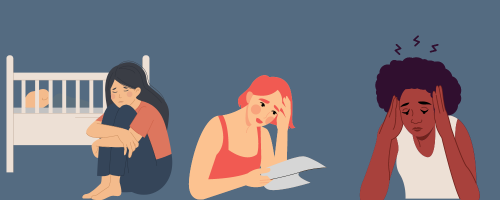Part of coping with pressure is recognising when it starts to become a problem.
That means being aware of how you are feeling as well as being alert to the signs and symptoms of too much pressure.

Pressure can be in the moment or long term
Too much of either kind is harmful physically and psychologically.
In-the-moment pressure can arise from everyday situations such as being late to work, being short-staffed or facing last minute demands.
Too much in-the-moment pressure makes people misread
situations and react inappropriately – with consequences that can last well beyond the moment.
Repeated often enough, in the-moment pressure also becomes a health risk.
Long-term pressure builds up over time and could be affected by both home and work issues.

Long-term pressure poses a much more serious health risk, as well as undermining people’s
judgement and behaviour.
In-the-moment pressure
How to recognise in-the-moment pressure.
People’s reactions vary, but here are some typical early signs:
Physical
- Digestive problems
- Nausea
- Light headedness
- Dry mouth
- Heart pounding
- Rashes or flushing
Emotional
- Immediate emotional judgement
- Short temper
- Feeling overwhelmed
- Paranoia
Behavioural
- Procrastinating
- Neglecting responsibilities
- Nervous habits such as pacing, nail biting
- Inability to concentrate
Thinking
- Seeing only the negative
- Constant worrying,
- Self-blame
- Poor judgement
Learning to recognise these early signs is one of the most important stages in developing resilience. It enables you to take action before the threat becomes overwhelming.
Strategies to cope with in-the-moment pressure
Strategies for coping with in-the-moment pressure focus on simple but highly effective techniques to relax, become more self-aware and regain control of your thoughts and feelings.
Techniques to relax when you feel under pressure
Breathe
Breathe in for a count of seven, out for 11.
Tighten, then relax
Tighten all your muscles for count of three, then let go. Repeat.
Movement
A quick walk, going up and down stairs, stretching – it doesn’t
have to be strenuous. Any sort of movement will help you destress.
Targeted muscle relaxation
Muscle tension is a very normal reaction to pressure and can
contribute to so-called ‘stress headaches’. Stomach, shoulders,
neck and jaw are all typical places to store tension. Notice where
you are tight and consciously relax the muscles.
Self-massage
(e.g. pressing your fingertips into the muscles in the back of your
neck, or your shoulders) is good way to find and release muscle
tension.
Techniques to manage thoughts and emotions
Firstly, Step out of the stressful situation
Literally walk away and give your attention to something else,
even if only for a moment. It gives you a chance to calm down
and regain control of thoughts and emotions.
Talk
Talking about thoughts and feelings can help to release tension.
All your colleague needs to do is listen and make sympathetic
noises while you talk. Putting things into words to another
person gives you distance and helps you calm down. It can also
give you a different perspective on the issue.
Notice what you are feeling
This is a mindfulness technique to help you manage emotion.
Ask yourself, ‘What am I actually feeling?’ Identify the feeling (or
feelings) – anger, fear, embarrassment, whatever. Don’t judge
yourself, don’t fight your feelings. Just observe and accept them.
Whatever they are, those are your feelings. Taking that step
back, becoming aware of your feelings and accepting them puts
you back in charge and lets you move on.
Break the cycle
When you find yourself caught up in a cycle of negative
thoughts, deliberately turn your attention to something positive
(e.g. a good memory, something good you’re going to do,
anything that makes you feel positive about yourself). This is a
distraction technique, the mental equivalent of stepping out of
the situation – into a place that reaffirms the good things in your
life.
Problem solve
When you find yourself worrying about something coming up,
something that seems overwhelming, stop and ask yourself,
‘What do I actually need to do about this?’ Mentally rehearse
how you will deal the situation. Think it through logically. If you
will need help, think who you will ask. This is a problem-solving
technique designed to put you back in charge.
Think positive
If you find yourself worrying about a problem, try talking to
yourself in a calm and logical way. If you are given a challenging
task at work, think of a time you have done something similar
and tell yourself you can do it again. Instead of seeing the task
as a negative, try and view it as a positive, for example ‘this will
be a great opportunity to move forward in my role’ or ‘to gain
more experience
Techniques to become more self aware
Often the trick is simply having the presence of mind to use them when you are caught up in the
pressure of the moment.
Use reflective discussion to support self-awareness
Reflective discussion is simply thinking about, or reflecting on,
what you do. Next time you experience in the moment pressure,
think about:
- What you did
- What happened
- What would you do different next time.
Know when to seek help
Being resilient is not about being self-sufficient. Resilience is
about thriving under pressure. Sourcing help when you need it is
a very resilient behaviour!
Mindfulness
The essence of mindfulness can be summed up in three words,
be here now.
Mindfulness involves paying full attention to your feelings,
thoughts and bodily sensations in the present moment. This
means standing aside from any other thoughts, worries, upsets,
plans etc. that normally absorb and preoccupy our mind.
Being mindful enables you to disengage from your worries and
upsets, to give you a break and some distance from everyday
stress, and helping you regain perspective and a deeper sense
of self.
Mindfulness training is about acquiring techniques to focus your attention in that way. You
can start by reminding yourself to take more notice of your thoughts and feelings. Tai-chi, yoga and
meditation are more formal ways of practicing mindfulness.
Long term pressure
How to recognise when long-term pressure becomes a problem.
Exposure to too much pressure over an extended period results in chronic stress. Chronic stress can produce a wide range of effects.
People can feel:
- Tense, agitated, irritable, tearful, moody, helpless, anxious,
- Depressed
- Weary – physically and mentally
- Apathetic, withdrawn
- Distracted, unable to concentrate.
They may experience problems with:
- Relaxation, sleep
- Judgement, memory
- Muscle tension, headaches, dizziness, nausea, stomach problems
- Frequent colds, minor infections.
Often people:
- Worry constantly, see only the negative, feel lonely and isolated
- Eat too much or too little
- Use caffeine, tobacco, alcohol and other drugs to help them cope
- Put things off.
Others are affected too:
- Feelings are infectious, behaviour is contagious.
- Too much pressure on one person can affect those working around them.
Signs to be aware of include:
- Conflicts and unhappiness
- Sickness absence
- Poor performance
- Complaints and grievances
- People quitting
Strategies to cope with long-term pressure
Look after your physical health and wellbeing
Types of things that can help you to look after your
physical health:
Eating a healthy diet
Not smoking
Taking regular exercise
Getting enough sleep.
They help protect your body from the effects of stress and maintain emotional balance and optimism.
Look after your mental health and wellbeing
These are the types of things that can help you to look after your
mental health:
Connection to other people
Physical activity
Doing something new
Taking an interest in your surroundings
Doing things for other people.
These things build your confidence and help you to flourish in the world in a positive way.
Establishing a boundary between work and home is key to establishing a sustainable work-life balance and helps you manage role conflicts.
What constitutes a good work-life balance is individual to you and changes over time, but it should ensure space to unwind properly, physically and psychologically.
Finally, try to dedicate some time every day to an activity that gives you both exercise and a moment to yourself.



